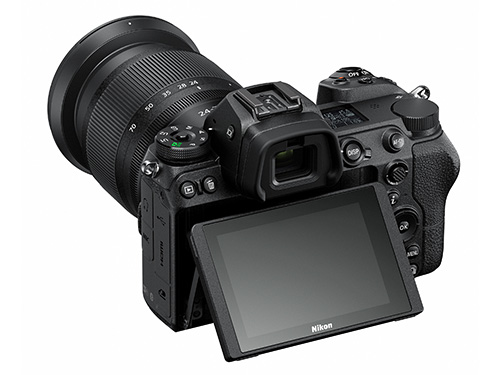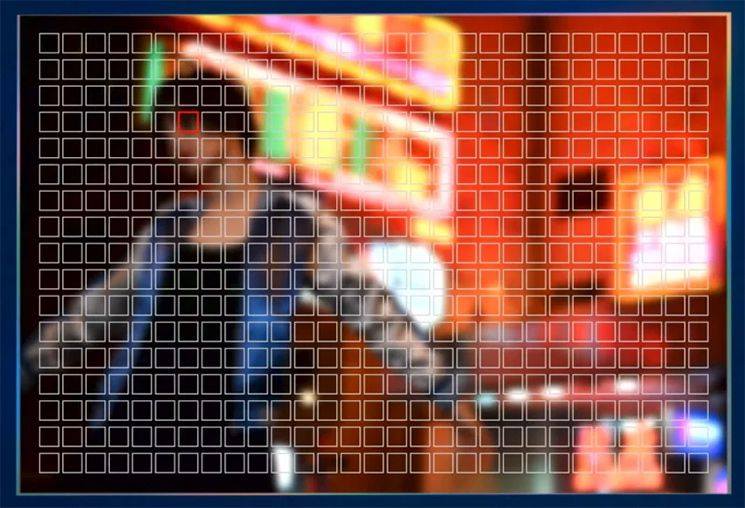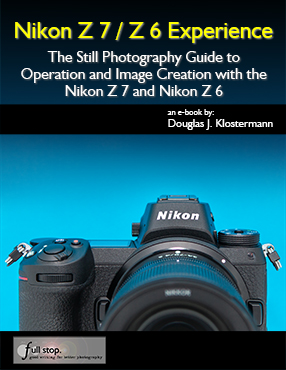After several years of speculation and anticipation, Nikon has just introduced their first full-frame mirrorless cameras, the Nikon Z 7 and the Nikon Z 6. The Z 7 is a high-resolution model boasting 45.7 MP, and the Z 6 is nearly the same camera, but has 24.5 MP, and costs $1996 vs. $3396 for the Z 7. There are some additional differences such as the number of autofocus points, and the ISO ranges.

Detail of the Nikon Z 7 full-frame mirrorless camera, including the 3.2″ tilting touch-screen monitor. Official Nikon image.
If you have been reading about these models, you have likely found numerous comparison posts between the two cameras, the Nikon D850 dSLR, plus the competing Sony a7R III and Sony a7 III mirrorless models. Simply comparing the specifications on the surface can be a helpful starting point, but we need to dig a little deeper in order to make true, user experience comparisons.
Continuous Frame Rate and Buffer
For example, the Nikon D850 dSLR lists a 9fps maximum burst rate, but users quickly discovered that this was based on the use of the optional MB-D18 battery grip and EN-EL18a/b battery. The maximum frame rate without the battery grip is 7 fps, and even then that rate is not achievable without the use of specific settings including AF-S, M or S shooting mode with a 1/250 or faster shutter speed, and various settings like VR and auto ISO turned off.
The Nikon Z 7 has a similar situation, with the maximum frame rate listed as 9 fps. However, this is rate can only be attained when capturing JPEG or 12-bit RAW files, and the exposure will be locked at the first frame of the burst. The camera will continue to update focus for each shot, when using AF-C focus mode, but not the exposure settings. When using Silent Mode, where shutter sound is completely eliminated, the maximum fps will be 8 fps. When capturing 14-bit RAW files, the maximum frame rate is reduced to 5.5 fps, however this will enable continuous focus, and exposure will be determined for each shot in the burst, and not just locked at the first shot. The maximum rate can be maintained for up to 18 continuous 14-bit compressed RAW images,or 23 12-bit lossless compressed images. Note that the Sony a7R III achieves up to 10 fps (with viewfinder blackout), or 8 fps without blackout, and exposure is not locked on the first exposure with either frame rate, unless desired. The Sony maximum rate can be attained for 40 RAW images, or 89 compressed RAW images. That is a significant difference, which Nikon will need to improve in future models.

Detail of the Nikon Z 7 full-frame mirrorless camera, including the new Z-mount lens mount. Official Nikon image.
Electronic Viewfinder and Touch Screen
Compared to a dSLR, mirrorless cameras such as the Z 7 and Z 6 make use of an electronic viewfinder (3690K dots) rather than an optical viewfinder. An electronic viewfinder can take a little bit to get accustomed to if you are used to working with the optical viewfinder of a dSLR, as there can be a little lag, the brightness changes with the scene and exposure, and it consumes battery life. However it has its advantages. An electronic viewfinder will reflect many of the actual camera settings, such as exposure, white balance, and Picture Control. This not only helps you envision the final image, but can save you in situations where you may have the wrong WB set. It also allows you to see and change certain camera settings, such as metering mode and autofocus modes, while looking through the viewfinder (by pressing the i Button to access a customizable settings screen). It also allows you to review images and movies in the viewfinder, without taking your eye away to view the rear screen.
The Z 7 and Z 6 provide a couple different ways to confirm focus, when manual focusing through the Viewfinder or on the rear Monitor. There is a Rangefinder feature, as found on many Nikon dSLR models, where you place the AF Point on your desired subject or detail, and as you manually focus, the AF Point will illuminate when that detail comes into focus. You can also enable Focus Peaking, where high-contrast edges of the actual subject or detail in the scene will illuminate when that distance is in focus. You can select which color is used to indicate focus. Focus Peaking is often used when manually focusing when shooting video, and still photographers have adapted the use of the feature as well.
The 3.2″ rear monitor has touch-screen capabilities for Live View, navigating menus, changing settings, and for locating your AF Point and autofocusing. This differs from the Sony a7R III, where the touch-screen is only used for Live View and for autofocusing.

Detail of the Nikon Z 7 full-frame mirrorless camera, including the rear monitor and controls. Official Nikon image.
Autofocus System
The AF system of the Z 7 and Z 6 is going to be slightly different than you may be used to with a Nikon dSLR. The hybrid AF system (phase-detection and contrast-detection) of the Z 7 has 493 AF points, and the Z 6 has 273 points, both covering 90% of the frame. That means you will be able to focus on and track subjects throughout almost the entire frame, without necessarily having to lock focus and recompose. The on-sensor phase-detection AF system is similar to Live View autofocusing, and thus should be spot-on without having to calibrate lenses (except for lenses that can’t take full advantage of the hybrid AF system, and instead rely on the contrast-detection system).
You will be able to use AF-S Focus Mode for still subjects, and AF-C for tracking moving subjects. The AF Area Modes differ slightly from a Nikon dSLR. You will be able to choose from Pinpoint AF for very precise AF Point positioning (in AF-S mode only), Single-Point AF, 9-point Dynamic-Area AF (in AF-C mode), Wide-Area AF, and Auto-Area AF. If you wish to take advantage of face detection, you will have to set for Auto-Area AF, and enable the Auto-Area AF Face Detection item of the menu. Nikon says that the face-detection will also look at the upper body of the subject, and thus will continue to track it even if the face is momentarily out of view.
Tracking a subject throughout the frame, similar to Nikon’s 3D-Tracking on a dSLR, will be done in Auto-Area AF and AF-C. The implementation of it is a bit different, however, and DP Review goes into detail about the new process. It is a bit more cumbersome than how it is done on a dSLR:
https://www.dpreview.com/reviews/nikon-z7-first-impressions-review/5

The 493 AF Points of the Nikon Z 7, covering 90% of the frame. Official Nikon image.
Other Features and Functions
The ISO range of the Z 7 is 64 – 25,600, expandable to 32 – 102,400. With its different sensor, the Z 6 has a wider ISO range on the high end, of 100 – 51,200, expandable to 50 – 204,800.
New Z-mount lens mount – Wider, which will allow for lenses such as the 52mm f/0.9 NOCT lens, coming from Nikon. Three lenses will be available at first, along with a Z to F ZTF Adapter to use Nikon F-mount lenses.
EXPEED 6 processor, new mid-range sharpening parameter, new Creative Picture Controls to create dramatically processed images, such as Dream, Bleached, and Graphite.
5-axis in-camera image stabilization, which will work with both lenses without VR, and lenses with VR.
~ ~ ~
To learn about all the features, functions, controls, and customizations of the Nikon Z 7 and Nikon Z 6, be sure to have a look at my Nikon Z 7 / Z 6 Experience. user guide, to be available in November or December 2018. It is a comprehensive 350+ page guide, to help you take control of your camera, and the images you create.
If you want to pre-order or order the Nikon Z 7 or Nikon Z 6, please consider using my affiliate links below. Your price will be the same, but they will give me a small commission – thanks!
Nikon Z 7 at Amazon: https://amzn.to/2MPaiU5 – $3396.95
Nikon Z 7 at B and H:
https://www.bhphotovideo.com/c/buy/Mirrorless_System_Cameras/ci/16158/N/4288586281/BI/7364/KBID/7886/kwid/000/DFF/d10-v1-t3-z4288586281
Nikon Z 6 at Amazon: https://amzn.to/2MKHSe0 – $1996.95
Nikon Z 6 at B and H:
https://www.bhphotovideo.com/c/buy/Mirrorless_System_Cameras/ci/16158/N/4288586281/BI/7364/KBID/7886/kwid/000/DFF/d10-v1-t3-z4288586281


